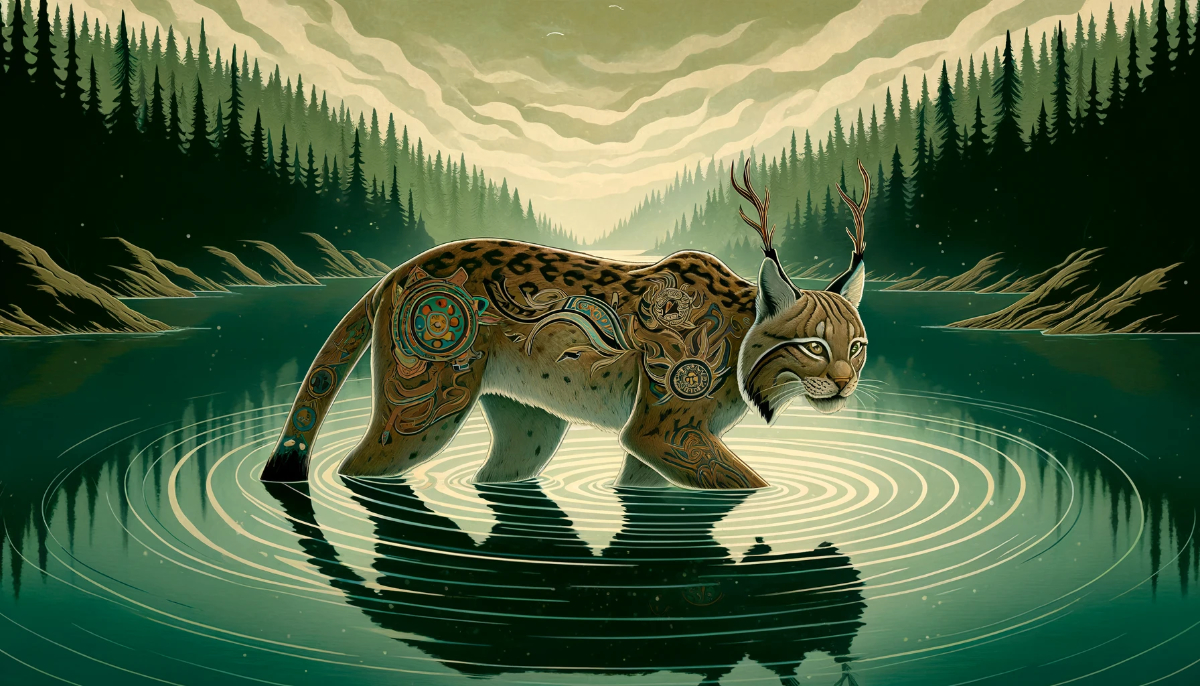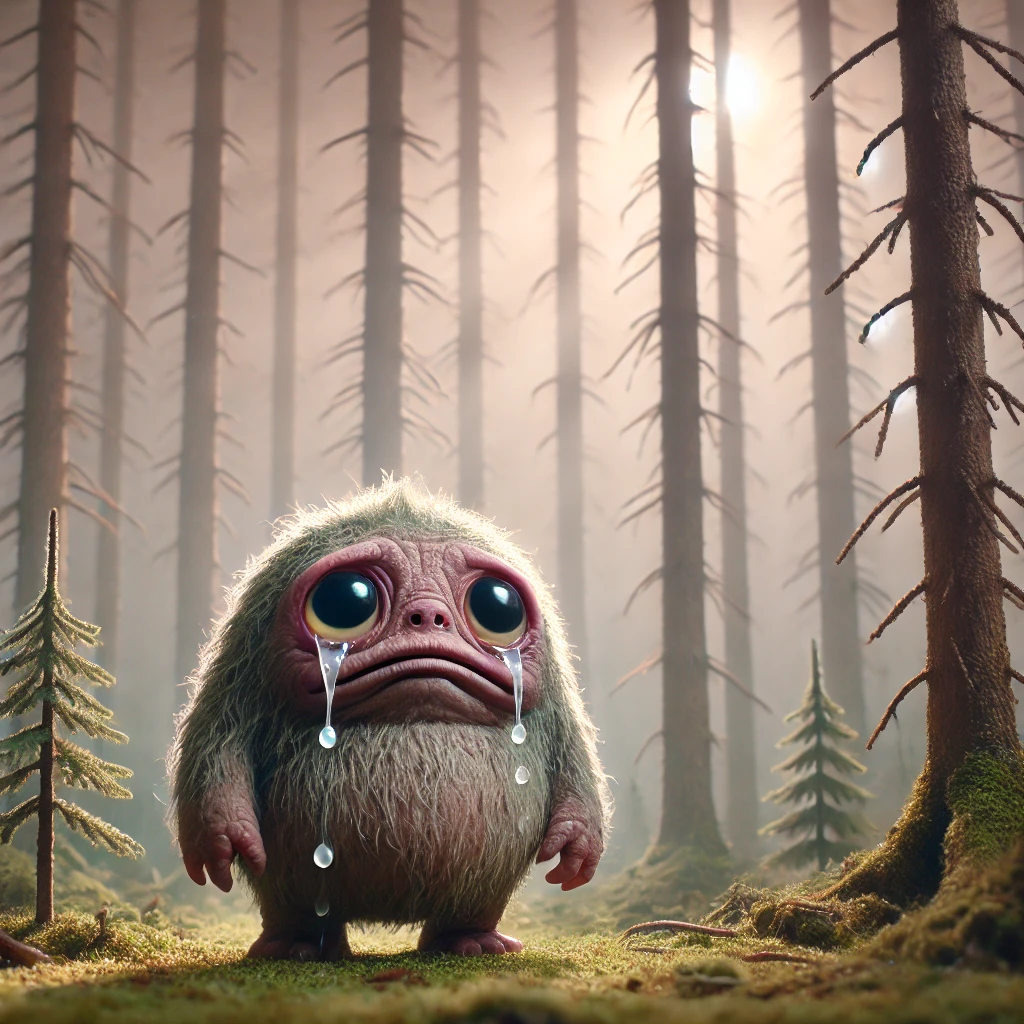Deep in the misty hemlock forests of Pennsylvania, a peculiar creature is said to roam. Known as the Squonk, this cryptid stands apart from fearsome monsters and elusive giants—it’s distinguished by its perpetual sorrow. This quirky yet poignant figure in American folklore symbolizes imperfection and fragility, offering a gentler kind of mystery than most cryptid legends provide.
Origins in the Lumber Camps
The Squonk emerged from Pennsylvania’s logging camps during the late 19th and early 20th centuries. Loggers working in the dense hemlock forests—particularly in north-central Pennsylvania’s lumber country—created a rich tradition of tall tales and folklore. These stories served multiple purposes: entertainment during long, grueling workdays; initiation rituals for newcomers; and creative expression in an otherwise harsh environment.
Lumber camp folklore produced numerous imaginary creatures, each more outlandish than the last. The tradition of “fearsome critters”—fantastical beasts said to inhabit the logging territories—gave workers a creative outlet and a shared cultural experience. Among these fabricated creatures, the Squonk stands out for its unusual characteristics and emotional depth.
Unlike aggressive predators or dangerous forest spirits, the Squonk was portrayed as pathetic rather than threatening. The creature’s defining trait wasn’t its size, strength, or elusiveness, but its overwhelming sadness—a quality that made it both memorable and oddly sympathetic.
The Legend Takes Shape
According to the traditional tales, the Squonk inhabits the shadowy hemlock forests, spending its days hiding and weeping. Described as a small, awkward creature with loose, ill-fitting skin covered in warts and blemishes, the Squonk is painfully aware of its unfortunate appearance. This self-consciousness drives it to avoid any contact with other creatures, retreating deeper into the forest to hide its perceived ugliness.
The creature’s most distinctive behavior—and the source of its name—involves constant weeping. Squonks supposedly cry continuously, leaving wet trails through the forest that hunters might follow. But here’s where the legend becomes particularly poignant: when finally cornered or captured, the Squonk’s distress becomes so overwhelming that it dissolves entirely into a puddle of its own tears.
This detail—the creature literally dissolving when confronted—serves a clever narrative purpose. It explains why no one has ever successfully captured or photographed a Squonk: the very act of catching one destroys the evidence. It’s the perfect unfalsifiable claim, a self-contained explanation for the creature’s continued mystery.
Cultural Context and Purpose
The Squonk legend reflects the social dynamics and environmental context of Pennsylvania’s logging camps. These camps housed men working dangerous jobs in isolated conditions, often far from families and communities. The stories they created and shared built camaraderie and provided psychological relief from difficult circumstances.
Lumber camp folklore also functioned as environmental commentary. The late 1800s and early 1900s saw massive deforestation in Pennsylvania, with old-growth hemlock forests being decimated for timber and tanbark. Some interpreters suggest the Squonk—a sad creature whose habitat was disappearing—unconsciously reflected loggers’ complex feelings about their work’s environmental impact.
The creature’s warty, unattractive appearance and constant tears might symbolize the damaged, altered landscape left behind by logging operations. Its tendency to dissolve when confronted could represent the vanishing wilderness itself, disappearing before anyone could properly document or preserve it.
The Squonk in Popular Culture
While the Squonk never achieved the fame of Bigfoot or the Loch Ness Monster, it has maintained a presence in popular culture. The creature appears in various compilations of American folklore and cryptozoology texts. Its gentle, melancholic nature makes it appealing to audiences seeking cryptids with personality beyond simple menace.
The progressive rock band Genesis famously featured the Squonk in their 1976 song “Squonk,” bringing the creature to international attention. The song’s lyrics reference the traditional folklore, describing the creature’s sadness and its unfortunate fate when captured. This musical tribute introduced the Squonk to audiences who might never have encountered Pennsylvania logging folklore otherwise.
Modern references to the Squonk often emphasize its relatability. In an age of social media and constant comparison, a creature that feels inadequate and hides from others resonates with contemporary anxieties. The Squonk has been adopted as a symbol for imperfection, vulnerability, and the universal experience of feeling flawed.
The Fearsome Critter Tradition
Understanding the Squonk requires examining the broader “fearsome critter” tradition from which it emerged. Lumber camps across North America produced similar folklore: imaginary creatures with outlandish characteristics and behaviors. These included the Hodag of Wisconsin, the Jackalope of the American West, and the Hoop Snake said to roll like a wheel.
These fabricated creatures served specific social functions. They provided entertainment, yes, but also operated as tests of credulity for newcomers. Experienced loggers would describe fearsome critters to new arrivals, gauging their gullibility and establishing camp hierarchy. The creatures became shibboleths—cultural knowledge that separated insiders from outsiders.
The Squonk fits this tradition while also subverting it. Where most fearsome critters represented exaggerated threats—dangerous predators with impossible abilities—the Squonk posed no danger whatsoever. Its threat was emotional rather than physical, making it an outlier among lumber camp creatures.
Folklore vs. Cryptozoology
Unlike Bigfoot or lake monsters, serious cryptozoologists don’t pursue the Squonk. The creature’s origins as deliberate fiction are well-documented and acknowledged. No one claims to have encountered a real Squonk, no blurry photographs exist, no footprints have been cast in plaster.
This clear distinction between intentional folklore and potential zoological mystery makes the Squonk valuable for understanding how legends function. We know the Squonk was created as entertainment and tall tale. We can examine its cultural purposes without the complications of evaluating evidence or debating existence.
The Squonk demonstrates how folklore serves purposes beyond literal truth. The story’s emotional resonance and cultural significance exist independently of whether Squonks actually inhabit Pennsylvania forests. The creature lives in shared cultural imagination, in the stories people tell and the meanings they find in those stories.
Lessons from a Crying Cryptid
What makes the Squonk enduringly appealing? Perhaps it’s the creature’s vulnerability in a genre usually dominated by fearsome monsters and elusive giants. The Squonk represents the part of us that feels inadequate, that wants to hide from judgment, that struggles with self-image and belonging.
In Monsters and Us: Unveiling North America’s Cryptid Mysteries, I explore how cryptid legends reflect human experiences and cultural values. The Squonk embodies our capacity for empathy toward the outcast and overlooked. Unlike monsters that inspire fear, the Squonk evokes sympathy—perhaps even recognition.
The creature also reminds us that not all folklore pursues the same goals. Where some legends preserve historical memory or teach survival skills, the Squonk simply asks us to consider the emotional lives of imaginary beings. It prioritizes feeling over function, melancholy over menace.
Pennsylvania’s Weeping Woods
The Squonk’s habitat—Pennsylvania’s hemlock forests—has changed dramatically since logging camp days. The old-growth forests that once covered much of the state are largely gone, replaced by second and third-growth timber. The landscape that birthed the Squonk legend exists now primarily in historical records and preserved fragments.
Yet the creature persists in cultural memory, kept alive through retelling, artistic interpretation, and scholarly examination. The Squonk has outlasted the lumber camps that created it, transcended its origins as deliberate fabrication, and found new audiences in each generation.
Modern Pennsylvania sometimes embraces its melancholy cryptid. Local festivals, craft breweries, and cultural organizations reference the Squonk, reclaiming it as regional heritage. The creature serves as a symbol of Pennsylvania’s logging history, environmental change, and the creativity that emerges from challenging circumstances.
The Enduring Appeal of Imperfection
The Squonk ultimately teaches us that legends need not inspire fear to capture imagination. This sad, ugly, dissolving creature resonates because it represents universal experiences: feeling inadequate, fearing judgment, struggling with self-image, and occasionally wanting to disappear entirely.
Where Bigfoot represents the mystery of unexplored wilderness and lake monsters embody the unknown depths, the Squonk symbolizes something more intimate and human: the experience of vulnerability itself. The creature’s tears aren’t evidence or clues—they’re empathy made manifest in folklore form.
The genius of the Squonk legend lies in its simplicity. The story requires no complicated backstory, no scientific explanations, no debate over evidence. A sad creature cries in the forest until it dissolves into its own tears. That’s all. And somehow, that’s enough to make it memorable across more than a century.
For deeper exploration of how cryptid legends like the Squonk reflect human experiences and cultural values, discover Monsters and Us: Unveiling North America’s Cryptid Mysteries. The book examines not just the creatures themselves, but what our fascination with them reveals about ourselves.
The Pennsylvania hemlock forests remain, whether or not they ever housed weeping Squonks. The legend continues, carrying forward lumber camp creativity and cultural memory. And somewhere in our collective imagination, the Squonk still wanders misty forests, shedding tears for reasons we understand all too well.
Related Articles

Mishipeshu: The Great Lynx of Ojibwa Lore
Explore the fascinating mythology of Mishipeshu, the powerful water spirit and guardian of the Great Lakes in Ojibwa culture.

Lake Monsters: The Hidden Giants of North American Waters
From Lake Champlain to Okanagan Lake, exploring the legends of mysterious creatures lurking in the depths of North America's lakes.
